Critical Analysis of Social Media Use in a Hospitality Business
VerifiedAdded on 2021/05/31
|20
|5867
|69
Report
AI Summary
This report critically evaluates the use of social media within the hospitality business, beginning with an introduction to web 2.0 and social media's role. A comprehensive literature review explores the relationship between social media and the hotel industry, the implications of social media, and the benefits and challenges associated with its use. The methodology involves data collection for a detailed case study on The Kimberly Hotel, Hong Kong, examining its social media strategies, their effectiveness, and resulting impact on tourist footfall. The report concludes with an analysis of the case study, highlighting the drawbacks of implemented strategies and offering actionable recommendations for the hotel to enhance its online presence, regain visitors, and improve customer engagement through social media platforms.
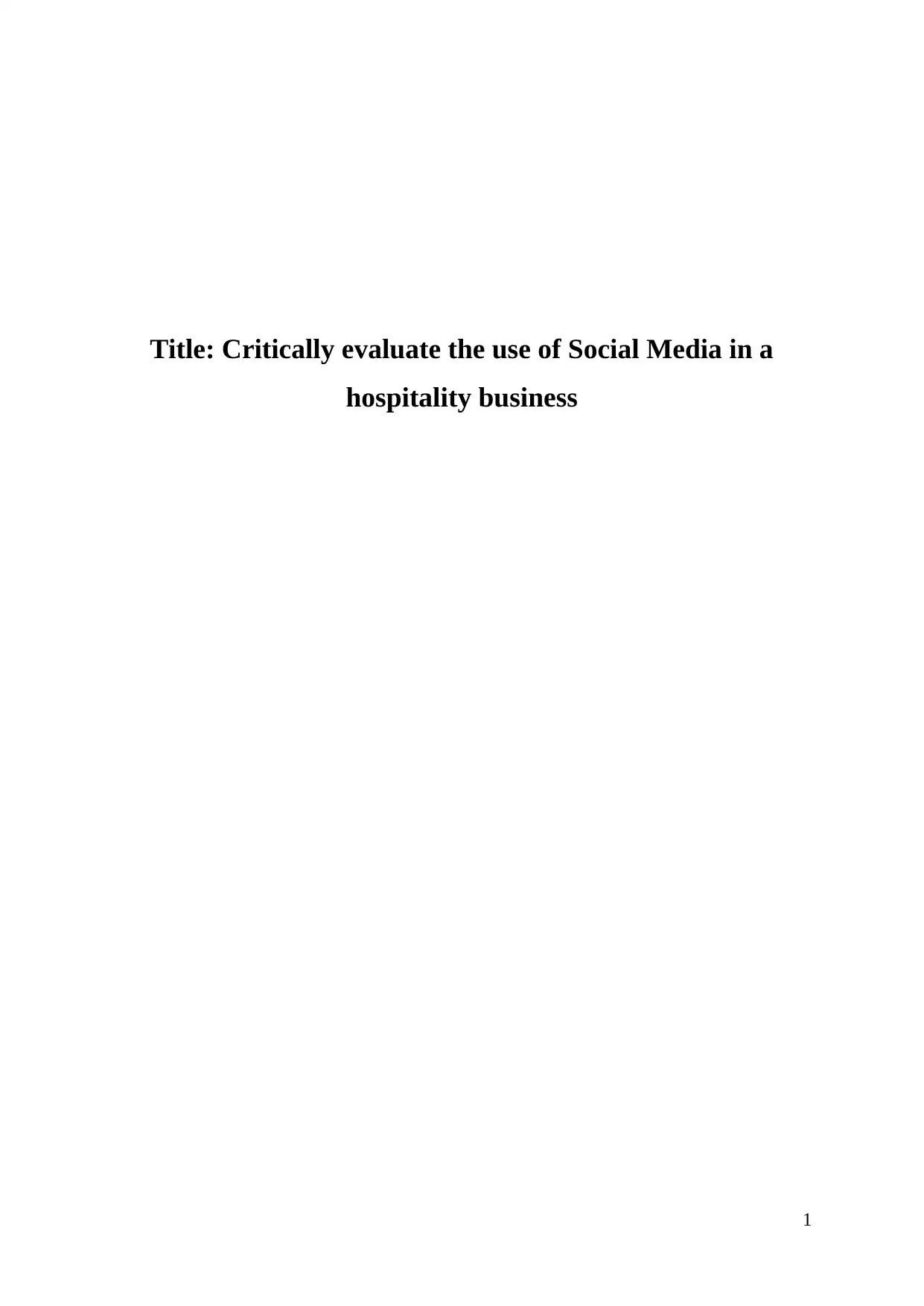
Title: Critically evaluate the use of Social Media in a
hospitality business
1
hospitality business
1
Paraphrase This Document
Need a fresh take? Get an instant paraphrase of this document with our AI Paraphraser
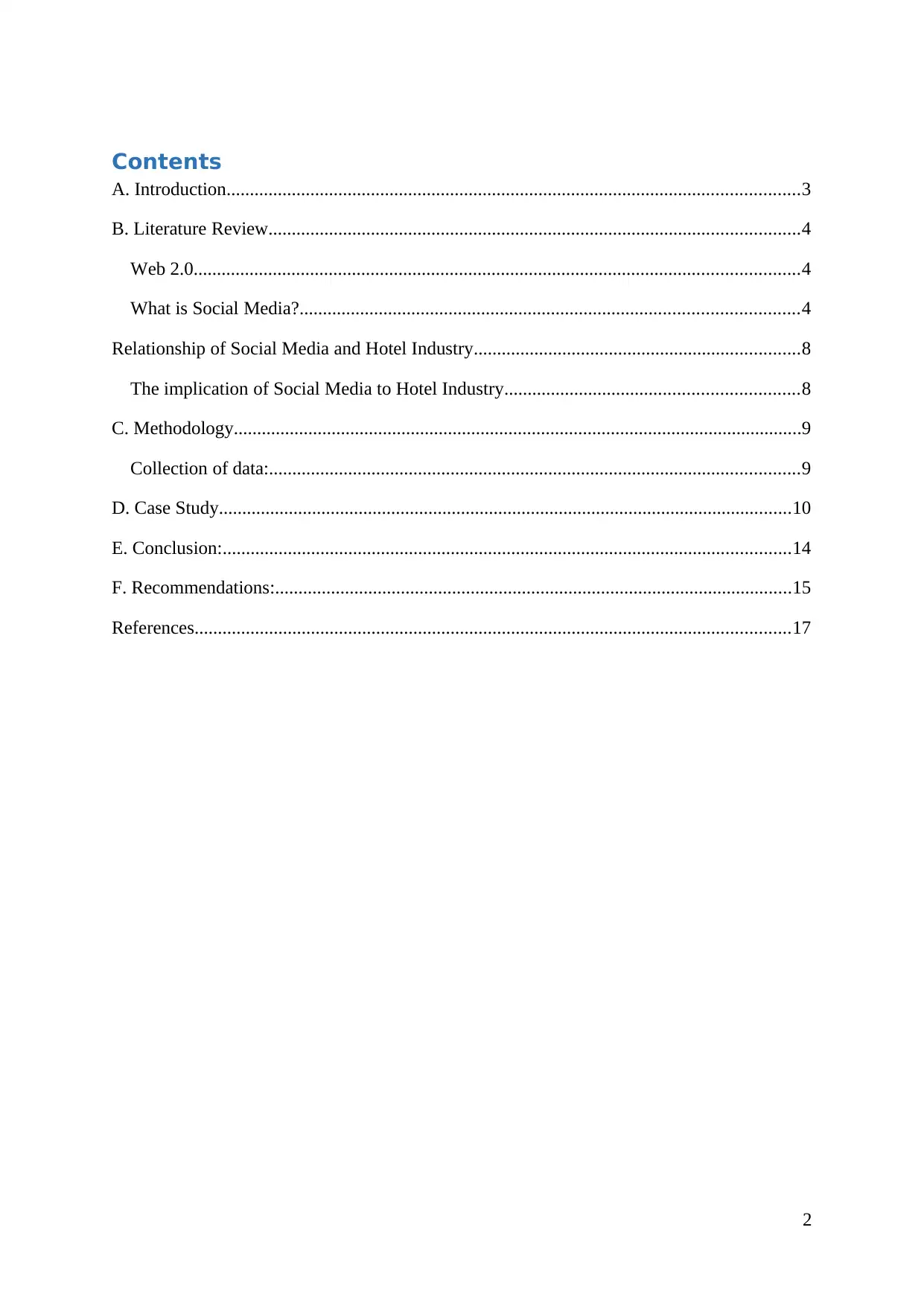
Contents
A. Introduction...........................................................................................................................3
B. Literature Review..................................................................................................................4
Web 2.0..................................................................................................................................4
What is Social Media?...........................................................................................................4
Relationship of Social Media and Hotel Industry......................................................................8
The implication of Social Media to Hotel Industry...............................................................8
C. Methodology..........................................................................................................................9
Collection of data:..................................................................................................................9
D. Case Study...........................................................................................................................10
E. Conclusion:..........................................................................................................................14
F. Recommendations:...............................................................................................................15
References................................................................................................................................17
2
A. Introduction...........................................................................................................................3
B. Literature Review..................................................................................................................4
Web 2.0..................................................................................................................................4
What is Social Media?...........................................................................................................4
Relationship of Social Media and Hotel Industry......................................................................8
The implication of Social Media to Hotel Industry...............................................................8
C. Methodology..........................................................................................................................9
Collection of data:..................................................................................................................9
D. Case Study...........................................................................................................................10
E. Conclusion:..........................................................................................................................14
F. Recommendations:...............................................................................................................15
References................................................................................................................................17
2
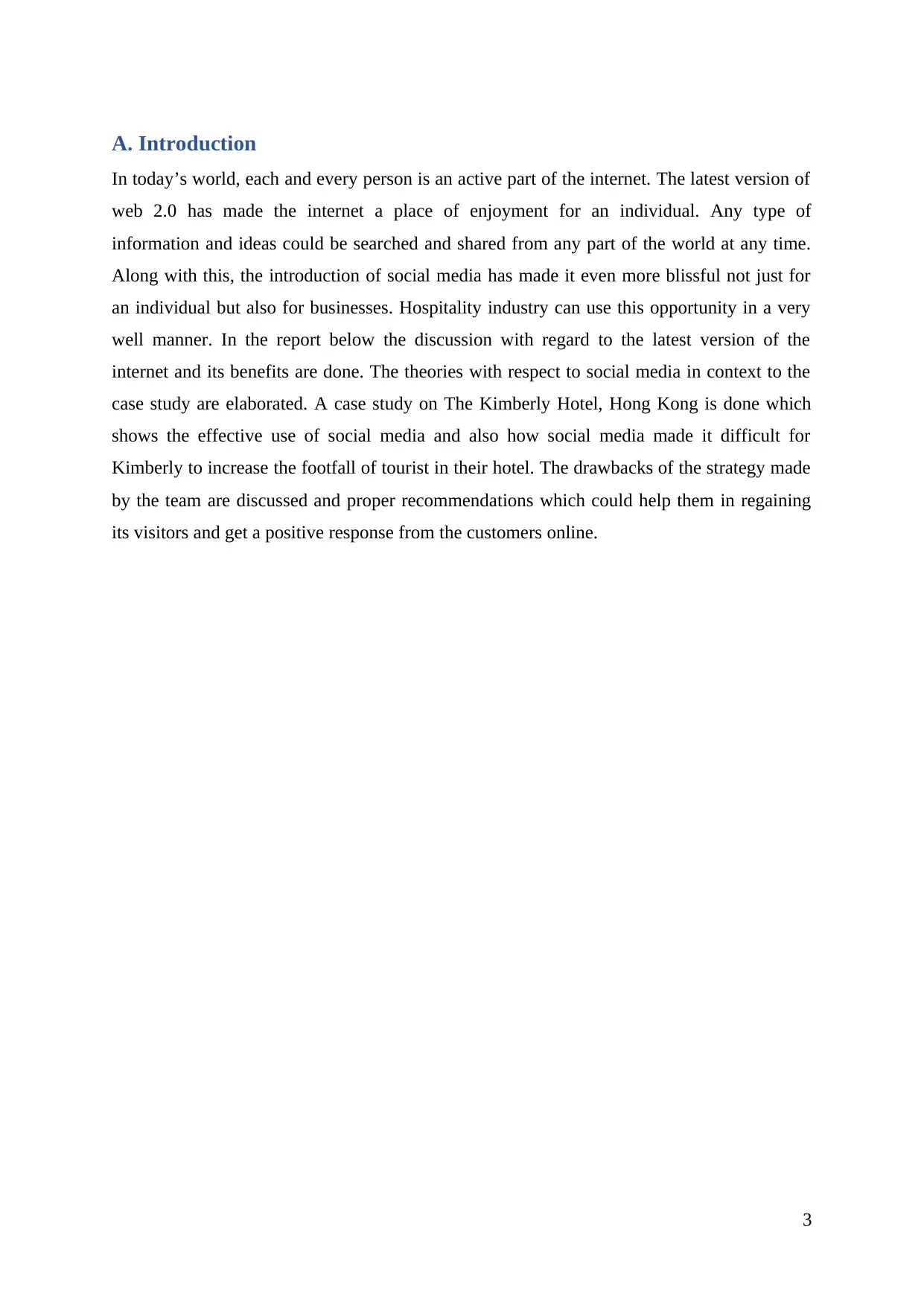
A. Introduction
In today’s world, each and every person is an active part of the internet. The latest version of
web 2.0 has made the internet a place of enjoyment for an individual. Any type of
information and ideas could be searched and shared from any part of the world at any time.
Along with this, the introduction of social media has made it even more blissful not just for
an individual but also for businesses. Hospitality industry can use this opportunity in a very
well manner. In the report below the discussion with regard to the latest version of the
internet and its benefits are done. The theories with respect to social media in context to the
case study are elaborated. A case study on The Kimberly Hotel, Hong Kong is done which
shows the effective use of social media and also how social media made it difficult for
Kimberly to increase the footfall of tourist in their hotel. The drawbacks of the strategy made
by the team are discussed and proper recommendations which could help them in regaining
its visitors and get a positive response from the customers online.
3
In today’s world, each and every person is an active part of the internet. The latest version of
web 2.0 has made the internet a place of enjoyment for an individual. Any type of
information and ideas could be searched and shared from any part of the world at any time.
Along with this, the introduction of social media has made it even more blissful not just for
an individual but also for businesses. Hospitality industry can use this opportunity in a very
well manner. In the report below the discussion with regard to the latest version of the
internet and its benefits are done. The theories with respect to social media in context to the
case study are elaborated. A case study on The Kimberly Hotel, Hong Kong is done which
shows the effective use of social media and also how social media made it difficult for
Kimberly to increase the footfall of tourist in their hotel. The drawbacks of the strategy made
by the team are discussed and proper recommendations which could help them in regaining
its visitors and get a positive response from the customers online.
3
⊘ This is a preview!⊘
Do you want full access?
Subscribe today to unlock all pages.

Trusted by 1+ million students worldwide
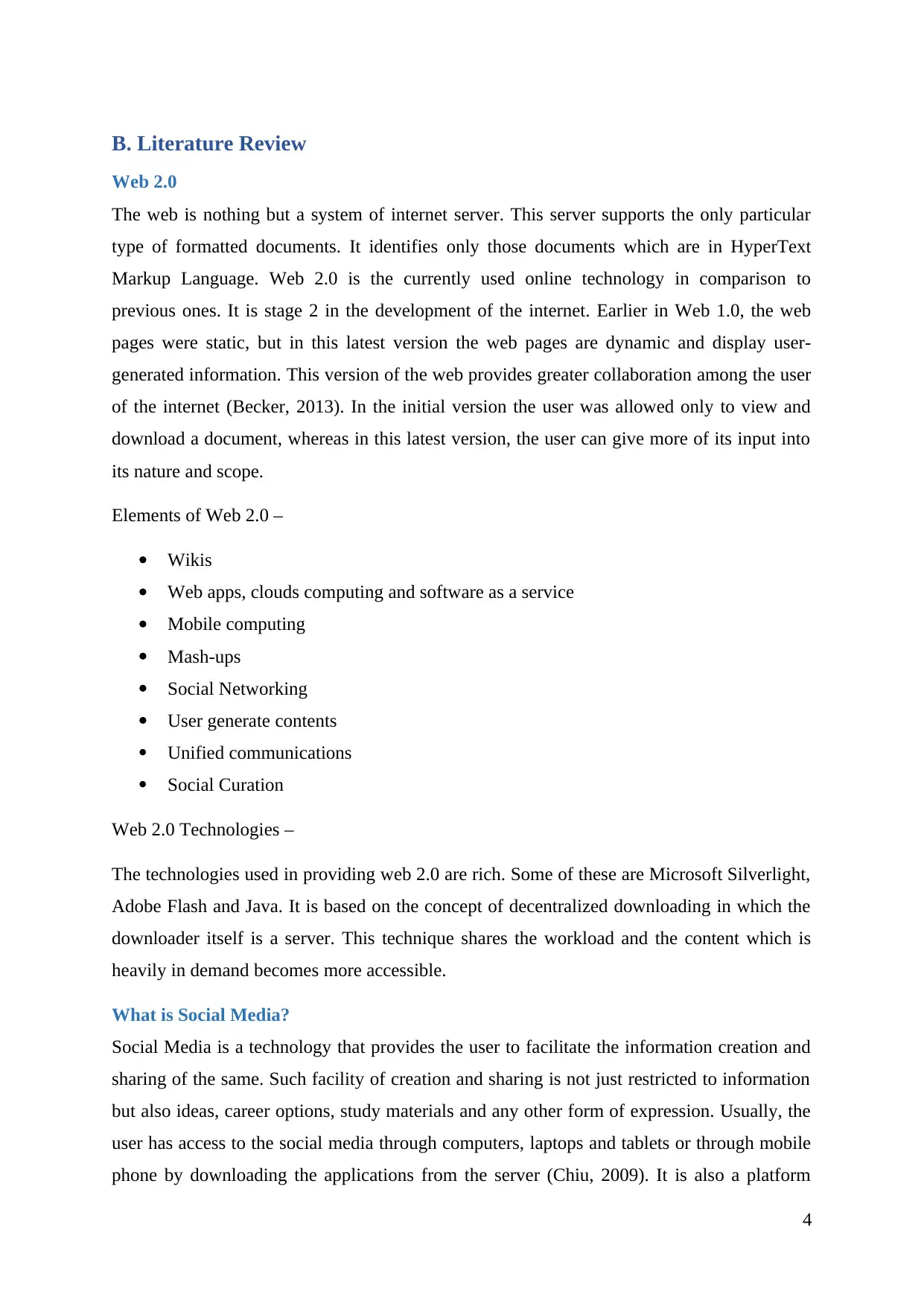
B. Literature Review
Web 2.0
The web is nothing but a system of internet server. This server supports the only particular
type of formatted documents. It identifies only those documents which are in HyperText
Markup Language. Web 2.0 is the currently used online technology in comparison to
previous ones. It is stage 2 in the development of the internet. Earlier in Web 1.0, the web
pages were static, but in this latest version the web pages are dynamic and display user-
generated information. This version of the web provides greater collaboration among the user
of the internet (Becker, 2013). In the initial version the user was allowed only to view and
download a document, whereas in this latest version, the user can give more of its input into
its nature and scope.
Elements of Web 2.0 –
Wikis
Web apps, clouds computing and software as a service
Mobile computing
Mash-ups
Social Networking
User generate contents
Unified communications
Social Curation
Web 2.0 Technologies –
The technologies used in providing web 2.0 are rich. Some of these are Microsoft Silverlight,
Adobe Flash and Java. It is based on the concept of decentralized downloading in which the
downloader itself is a server. This technique shares the workload and the content which is
heavily in demand becomes more accessible.
What is Social Media?
Social Media is a technology that provides the user to facilitate the information creation and
sharing of the same. Such facility of creation and sharing is not just restricted to information
but also ideas, career options, study materials and any other form of expression. Usually, the
user has access to the social media through computers, laptops and tablets or through mobile
phone by downloading the applications from the server (Chiu, 2009). It is also a platform
4
Web 2.0
The web is nothing but a system of internet server. This server supports the only particular
type of formatted documents. It identifies only those documents which are in HyperText
Markup Language. Web 2.0 is the currently used online technology in comparison to
previous ones. It is stage 2 in the development of the internet. Earlier in Web 1.0, the web
pages were static, but in this latest version the web pages are dynamic and display user-
generated information. This version of the web provides greater collaboration among the user
of the internet (Becker, 2013). In the initial version the user was allowed only to view and
download a document, whereas in this latest version, the user can give more of its input into
its nature and scope.
Elements of Web 2.0 –
Wikis
Web apps, clouds computing and software as a service
Mobile computing
Mash-ups
Social Networking
User generate contents
Unified communications
Social Curation
Web 2.0 Technologies –
The technologies used in providing web 2.0 are rich. Some of these are Microsoft Silverlight,
Adobe Flash and Java. It is based on the concept of decentralized downloading in which the
downloader itself is a server. This technique shares the workload and the content which is
heavily in demand becomes more accessible.
What is Social Media?
Social Media is a technology that provides the user to facilitate the information creation and
sharing of the same. Such facility of creation and sharing is not just restricted to information
but also ideas, career options, study materials and any other form of expression. Usually, the
user has access to the social media through computers, laptops and tablets or through mobile
phone by downloading the applications from the server (Chiu, 2009). It is also a platform
4
Paraphrase This Document
Need a fresh take? Get an instant paraphrase of this document with our AI Paraphraser
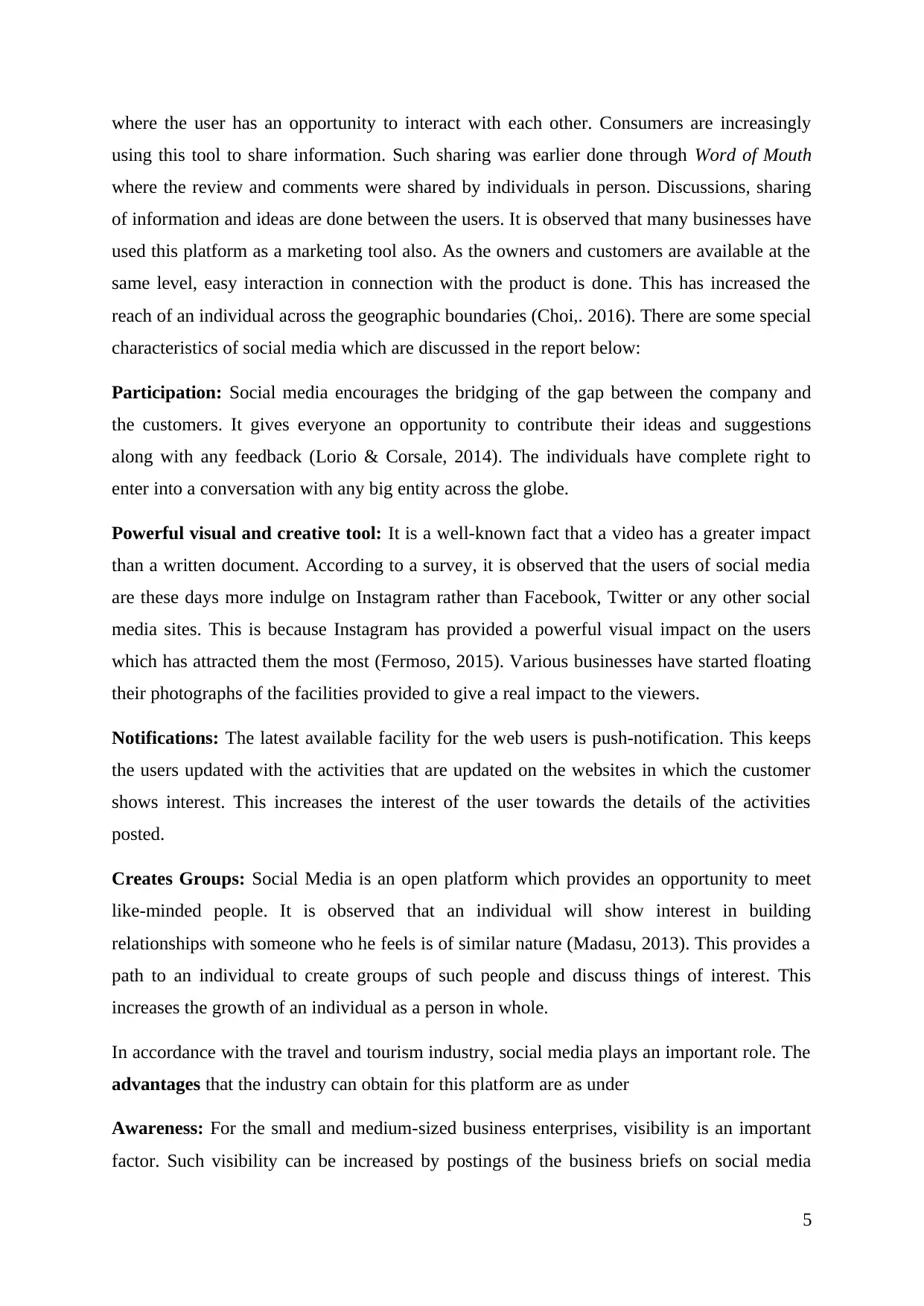
where the user has an opportunity to interact with each other. Consumers are increasingly
using this tool to share information. Such sharing was earlier done through Word of Mouth
where the review and comments were shared by individuals in person. Discussions, sharing
of information and ideas are done between the users. It is observed that many businesses have
used this platform as a marketing tool also. As the owners and customers are available at the
same level, easy interaction in connection with the product is done. This has increased the
reach of an individual across the geographic boundaries (Choi,. 2016). There are some special
characteristics of social media which are discussed in the report below:
Participation: Social media encourages the bridging of the gap between the company and
the customers. It gives everyone an opportunity to contribute their ideas and suggestions
along with any feedback (Lorio & Corsale, 2014). The individuals have complete right to
enter into a conversation with any big entity across the globe.
Powerful visual and creative tool: It is a well-known fact that a video has a greater impact
than a written document. According to a survey, it is observed that the users of social media
are these days more indulge on Instagram rather than Facebook, Twitter or any other social
media sites. This is because Instagram has provided a powerful visual impact on the users
which has attracted them the most (Fermoso, 2015). Various businesses have started floating
their photographs of the facilities provided to give a real impact to the viewers.
Notifications: The latest available facility for the web users is push-notification. This keeps
the users updated with the activities that are updated on the websites in which the customer
shows interest. This increases the interest of the user towards the details of the activities
posted.
Creates Groups: Social Media is an open platform which provides an opportunity to meet
like-minded people. It is observed that an individual will show interest in building
relationships with someone who he feels is of similar nature (Madasu, 2013). This provides a
path to an individual to create groups of such people and discuss things of interest. This
increases the growth of an individual as a person in whole.
In accordance with the travel and tourism industry, social media plays an important role. The
advantages that the industry can obtain for this platform are as under
Awareness: For the small and medium-sized business enterprises, visibility is an important
factor. Such visibility can be increased by postings of the business briefs on social media
5
using this tool to share information. Such sharing was earlier done through Word of Mouth
where the review and comments were shared by individuals in person. Discussions, sharing
of information and ideas are done between the users. It is observed that many businesses have
used this platform as a marketing tool also. As the owners and customers are available at the
same level, easy interaction in connection with the product is done. This has increased the
reach of an individual across the geographic boundaries (Choi,. 2016). There are some special
characteristics of social media which are discussed in the report below:
Participation: Social media encourages the bridging of the gap between the company and
the customers. It gives everyone an opportunity to contribute their ideas and suggestions
along with any feedback (Lorio & Corsale, 2014). The individuals have complete right to
enter into a conversation with any big entity across the globe.
Powerful visual and creative tool: It is a well-known fact that a video has a greater impact
than a written document. According to a survey, it is observed that the users of social media
are these days more indulge on Instagram rather than Facebook, Twitter or any other social
media sites. This is because Instagram has provided a powerful visual impact on the users
which has attracted them the most (Fermoso, 2015). Various businesses have started floating
their photographs of the facilities provided to give a real impact to the viewers.
Notifications: The latest available facility for the web users is push-notification. This keeps
the users updated with the activities that are updated on the websites in which the customer
shows interest. This increases the interest of the user towards the details of the activities
posted.
Creates Groups: Social Media is an open platform which provides an opportunity to meet
like-minded people. It is observed that an individual will show interest in building
relationships with someone who he feels is of similar nature (Madasu, 2013). This provides a
path to an individual to create groups of such people and discuss things of interest. This
increases the growth of an individual as a person in whole.
In accordance with the travel and tourism industry, social media plays an important role. The
advantages that the industry can obtain for this platform are as under
Awareness: For the small and medium-sized business enterprises, visibility is an important
factor. Such visibility can be increased by postings of the business briefs on social media
5
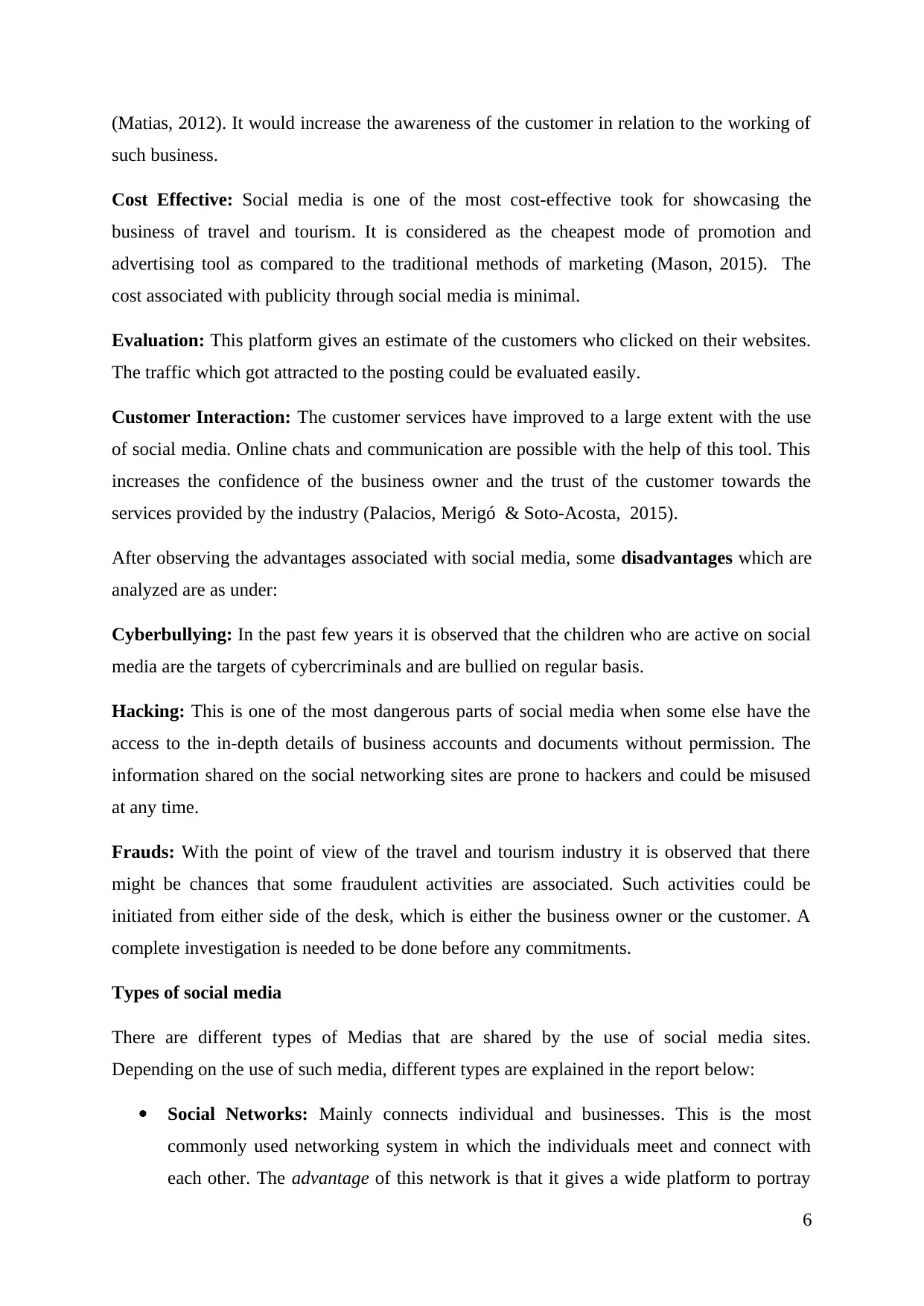
(Matias, 2012). It would increase the awareness of the customer in relation to the working of
such business.
Cost Effective: Social media is one of the most cost-effective took for showcasing the
business of travel and tourism. It is considered as the cheapest mode of promotion and
advertising tool as compared to the traditional methods of marketing (Mason, 2015). The
cost associated with publicity through social media is minimal.
Evaluation: This platform gives an estimate of the customers who clicked on their websites.
The traffic which got attracted to the posting could be evaluated easily.
Customer Interaction: The customer services have improved to a large extent with the use
of social media. Online chats and communication are possible with the help of this tool. This
increases the confidence of the business owner and the trust of the customer towards the
services provided by the industry (Palacios, Merigó & Soto-Acosta, 2015).
After observing the advantages associated with social media, some disadvantages which are
analyzed are as under:
Cyberbullying: In the past few years it is observed that the children who are active on social
media are the targets of cybercriminals and are bullied on regular basis.
Hacking: This is one of the most dangerous parts of social media when some else have the
access to the in-depth details of business accounts and documents without permission. The
information shared on the social networking sites are prone to hackers and could be misused
at any time.
Frauds: With the point of view of the travel and tourism industry it is observed that there
might be chances that some fraudulent activities are associated. Such activities could be
initiated from either side of the desk, which is either the business owner or the customer. A
complete investigation is needed to be done before any commitments.
Types of social media
There are different types of Medias that are shared by the use of social media sites.
Depending on the use of such media, different types are explained in the report below:
Social Networks: Mainly connects individual and businesses. This is the most
commonly used networking system in which the individuals meet and connect with
each other. The advantage of this network is that it gives a wide platform to portray
6
such business.
Cost Effective: Social media is one of the most cost-effective took for showcasing the
business of travel and tourism. It is considered as the cheapest mode of promotion and
advertising tool as compared to the traditional methods of marketing (Mason, 2015). The
cost associated with publicity through social media is minimal.
Evaluation: This platform gives an estimate of the customers who clicked on their websites.
The traffic which got attracted to the posting could be evaluated easily.
Customer Interaction: The customer services have improved to a large extent with the use
of social media. Online chats and communication are possible with the help of this tool. This
increases the confidence of the business owner and the trust of the customer towards the
services provided by the industry (Palacios, Merigó & Soto-Acosta, 2015).
After observing the advantages associated with social media, some disadvantages which are
analyzed are as under:
Cyberbullying: In the past few years it is observed that the children who are active on social
media are the targets of cybercriminals and are bullied on regular basis.
Hacking: This is one of the most dangerous parts of social media when some else have the
access to the in-depth details of business accounts and documents without permission. The
information shared on the social networking sites are prone to hackers and could be misused
at any time.
Frauds: With the point of view of the travel and tourism industry it is observed that there
might be chances that some fraudulent activities are associated. Such activities could be
initiated from either side of the desk, which is either the business owner or the customer. A
complete investigation is needed to be done before any commitments.
Types of social media
There are different types of Medias that are shared by the use of social media sites.
Depending on the use of such media, different types are explained in the report below:
Social Networks: Mainly connects individual and businesses. This is the most
commonly used networking system in which the individuals meet and connect with
each other. The advantage of this network is that it gives a wide platform to portray
6
⊘ This is a preview!⊘
Do you want full access?
Subscribe today to unlock all pages.

Trusted by 1+ million students worldwide
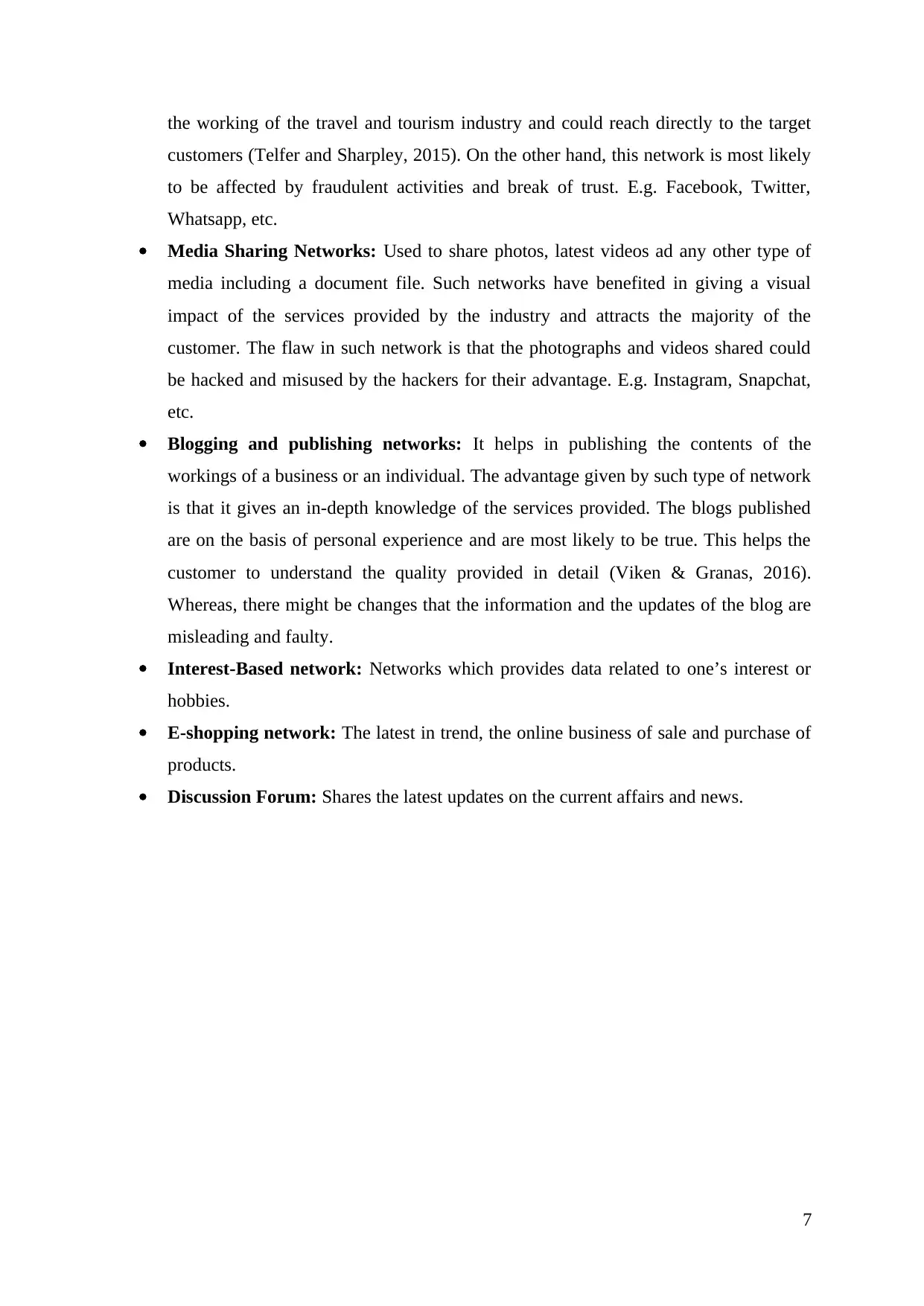
the working of the travel and tourism industry and could reach directly to the target
customers (Telfer and Sharpley, 2015). On the other hand, this network is most likely
to be affected by fraudulent activities and break of trust. E.g. Facebook, Twitter,
Whatsapp, etc.
Media Sharing Networks: Used to share photos, latest videos ad any other type of
media including a document file. Such networks have benefited in giving a visual
impact of the services provided by the industry and attracts the majority of the
customer. The flaw in such network is that the photographs and videos shared could
be hacked and misused by the hackers for their advantage. E.g. Instagram, Snapchat,
etc.
Blogging and publishing networks: It helps in publishing the contents of the
workings of a business or an individual. The advantage given by such type of network
is that it gives an in-depth knowledge of the services provided. The blogs published
are on the basis of personal experience and are most likely to be true. This helps the
customer to understand the quality provided in detail (Viken & Granas, 2016).
Whereas, there might be changes that the information and the updates of the blog are
misleading and faulty.
Interest-Based network: Networks which provides data related to one’s interest or
hobbies.
E-shopping network: The latest in trend, the online business of sale and purchase of
products.
Discussion Forum: Shares the latest updates on the current affairs and news.
7
customers (Telfer and Sharpley, 2015). On the other hand, this network is most likely
to be affected by fraudulent activities and break of trust. E.g. Facebook, Twitter,
Whatsapp, etc.
Media Sharing Networks: Used to share photos, latest videos ad any other type of
media including a document file. Such networks have benefited in giving a visual
impact of the services provided by the industry and attracts the majority of the
customer. The flaw in such network is that the photographs and videos shared could
be hacked and misused by the hackers for their advantage. E.g. Instagram, Snapchat,
etc.
Blogging and publishing networks: It helps in publishing the contents of the
workings of a business or an individual. The advantage given by such type of network
is that it gives an in-depth knowledge of the services provided. The blogs published
are on the basis of personal experience and are most likely to be true. This helps the
customer to understand the quality provided in detail (Viken & Granas, 2016).
Whereas, there might be changes that the information and the updates of the blog are
misleading and faulty.
Interest-Based network: Networks which provides data related to one’s interest or
hobbies.
E-shopping network: The latest in trend, the online business of sale and purchase of
products.
Discussion Forum: Shares the latest updates on the current affairs and news.
7
Paraphrase This Document
Need a fresh take? Get an instant paraphrase of this document with our AI Paraphraser
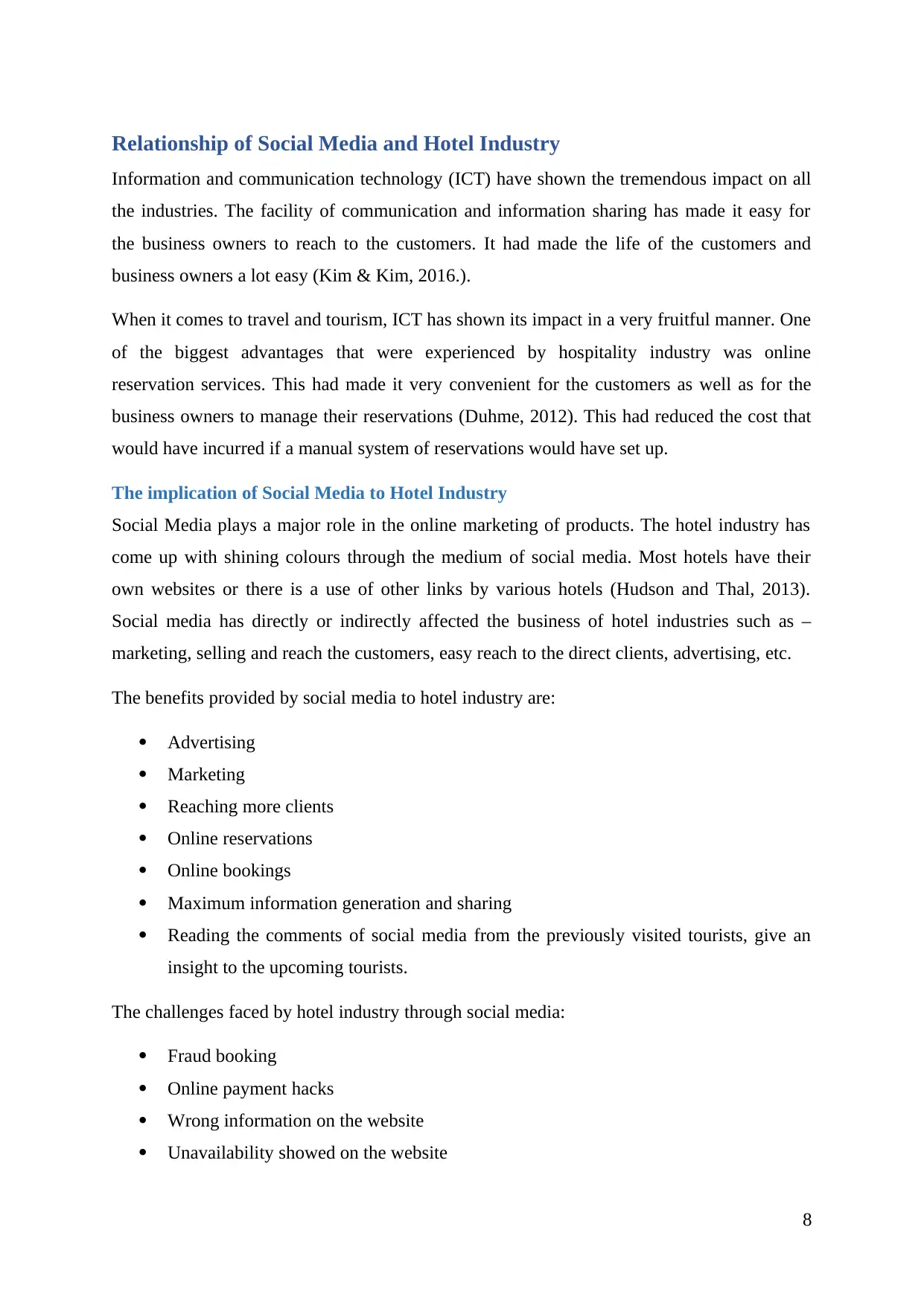
Relationship of Social Media and Hotel Industry
Information and communication technology (ICT) have shown the tremendous impact on all
the industries. The facility of communication and information sharing has made it easy for
the business owners to reach to the customers. It had made the life of the customers and
business owners a lot easy (Kim & Kim, 2016.).
When it comes to travel and tourism, ICT has shown its impact in a very fruitful manner. One
of the biggest advantages that were experienced by hospitality industry was online
reservation services. This had made it very convenient for the customers as well as for the
business owners to manage their reservations (Duhme, 2012). This had reduced the cost that
would have incurred if a manual system of reservations would have set up.
The implication of Social Media to Hotel Industry
Social Media plays a major role in the online marketing of products. The hotel industry has
come up with shining colours through the medium of social media. Most hotels have their
own websites or there is a use of other links by various hotels (Hudson and Thal, 2013).
Social media has directly or indirectly affected the business of hotel industries such as –
marketing, selling and reach the customers, easy reach to the direct clients, advertising, etc.
The benefits provided by social media to hotel industry are:
Advertising
Marketing
Reaching more clients
Online reservations
Online bookings
Maximum information generation and sharing
Reading the comments of social media from the previously visited tourists, give an
insight to the upcoming tourists.
The challenges faced by hotel industry through social media:
Fraud booking
Online payment hacks
Wrong information on the website
Unavailability showed on the website
8
Information and communication technology (ICT) have shown the tremendous impact on all
the industries. The facility of communication and information sharing has made it easy for
the business owners to reach to the customers. It had made the life of the customers and
business owners a lot easy (Kim & Kim, 2016.).
When it comes to travel and tourism, ICT has shown its impact in a very fruitful manner. One
of the biggest advantages that were experienced by hospitality industry was online
reservation services. This had made it very convenient for the customers as well as for the
business owners to manage their reservations (Duhme, 2012). This had reduced the cost that
would have incurred if a manual system of reservations would have set up.
The implication of Social Media to Hotel Industry
Social Media plays a major role in the online marketing of products. The hotel industry has
come up with shining colours through the medium of social media. Most hotels have their
own websites or there is a use of other links by various hotels (Hudson and Thal, 2013).
Social media has directly or indirectly affected the business of hotel industries such as –
marketing, selling and reach the customers, easy reach to the direct clients, advertising, etc.
The benefits provided by social media to hotel industry are:
Advertising
Marketing
Reaching more clients
Online reservations
Online bookings
Maximum information generation and sharing
Reading the comments of social media from the previously visited tourists, give an
insight to the upcoming tourists.
The challenges faced by hotel industry through social media:
Fraud booking
Online payment hacks
Wrong information on the website
Unavailability showed on the website
8
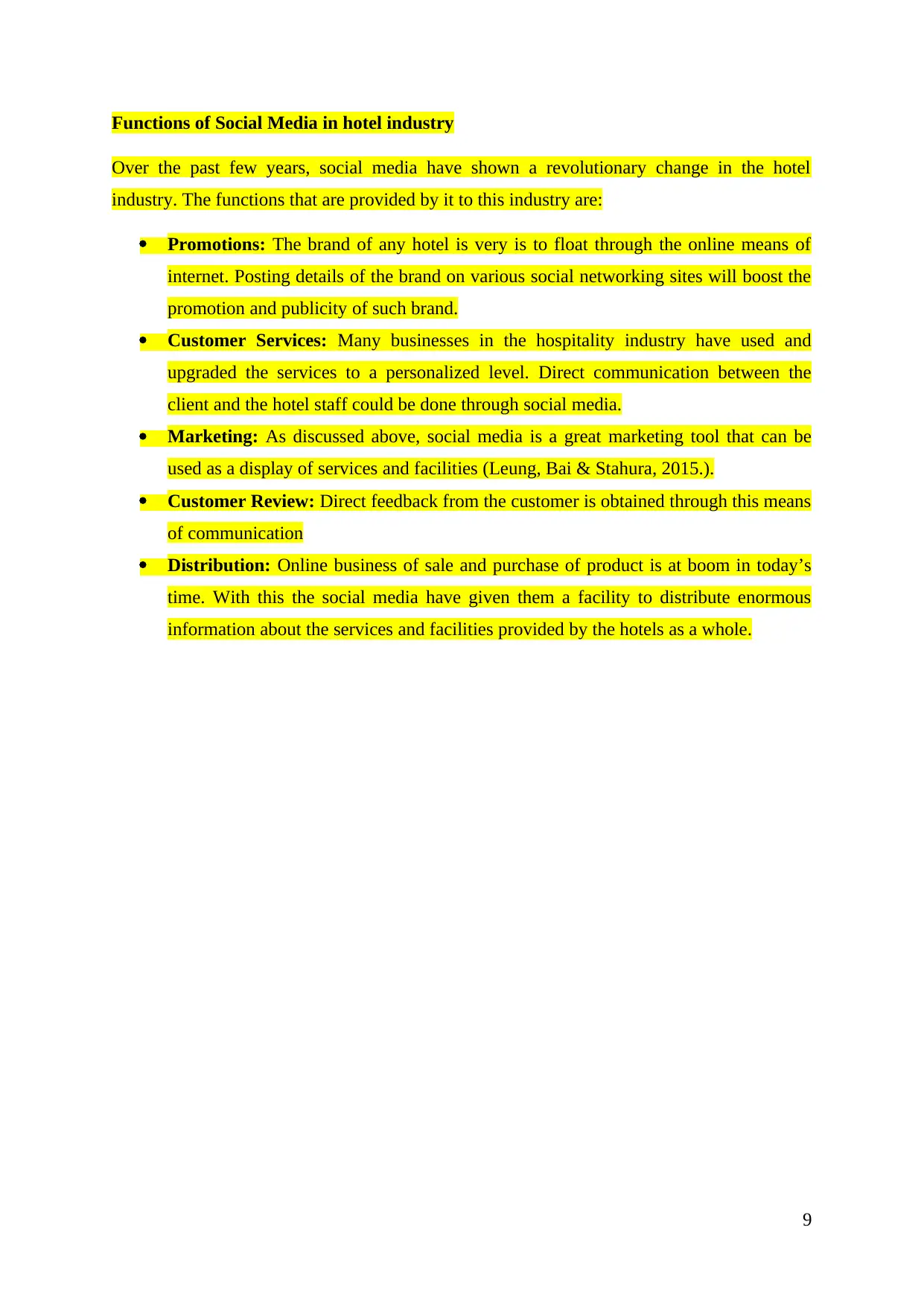
Functions of Social Media in hotel industry
Over the past few years, social media have shown a revolutionary change in the hotel
industry. The functions that are provided by it to this industry are:
Promotions: The brand of any hotel is very is to float through the online means of
internet. Posting details of the brand on various social networking sites will boost the
promotion and publicity of such brand.
Customer Services: Many businesses in the hospitality industry have used and
upgraded the services to a personalized level. Direct communication between the
client and the hotel staff could be done through social media.
Marketing: As discussed above, social media is a great marketing tool that can be
used as a display of services and facilities (Leung, Bai & Stahura, 2015.).
Customer Review: Direct feedback from the customer is obtained through this means
of communication
Distribution: Online business of sale and purchase of product is at boom in today’s
time. With this the social media have given them a facility to distribute enormous
information about the services and facilities provided by the hotels as a whole.
9
Over the past few years, social media have shown a revolutionary change in the hotel
industry. The functions that are provided by it to this industry are:
Promotions: The brand of any hotel is very is to float through the online means of
internet. Posting details of the brand on various social networking sites will boost the
promotion and publicity of such brand.
Customer Services: Many businesses in the hospitality industry have used and
upgraded the services to a personalized level. Direct communication between the
client and the hotel staff could be done through social media.
Marketing: As discussed above, social media is a great marketing tool that can be
used as a display of services and facilities (Leung, Bai & Stahura, 2015.).
Customer Review: Direct feedback from the customer is obtained through this means
of communication
Distribution: Online business of sale and purchase of product is at boom in today’s
time. With this the social media have given them a facility to distribute enormous
information about the services and facilities provided by the hotels as a whole.
9
⊘ This is a preview!⊘
Do you want full access?
Subscribe today to unlock all pages.

Trusted by 1+ million students worldwide
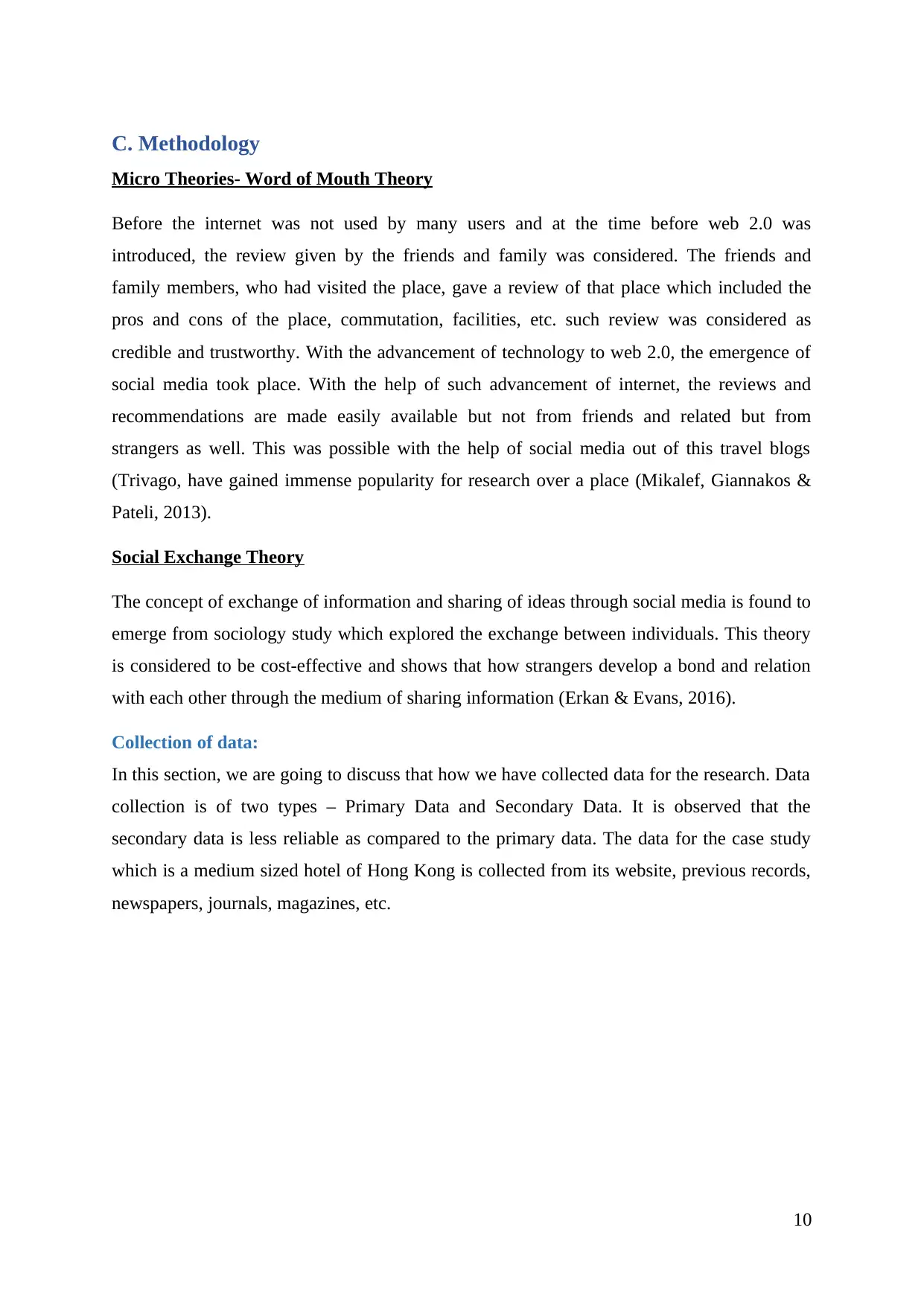
C. Methodology
Micro Theories- Word of Mouth Theory
Before the internet was not used by many users and at the time before web 2.0 was
introduced, the review given by the friends and family was considered. The friends and
family members, who had visited the place, gave a review of that place which included the
pros and cons of the place, commutation, facilities, etc. such review was considered as
credible and trustworthy. With the advancement of technology to web 2.0, the emergence of
social media took place. With the help of such advancement of internet, the reviews and
recommendations are made easily available but not from friends and related but from
strangers as well. This was possible with the help of social media out of this travel blogs
(Trivago, have gained immense popularity for research over a place (Mikalef, Giannakos &
Pateli, 2013).
Social Exchange Theory
The concept of exchange of information and sharing of ideas through social media is found to
emerge from sociology study which explored the exchange between individuals. This theory
is considered to be cost-effective and shows that how strangers develop a bond and relation
with each other through the medium of sharing information (Erkan & Evans, 2016).
Collection of data:
In this section, we are going to discuss that how we have collected data for the research. Data
collection is of two types – Primary Data and Secondary Data. It is observed that the
secondary data is less reliable as compared to the primary data. The data for the case study
which is a medium sized hotel of Hong Kong is collected from its website, previous records,
newspapers, journals, magazines, etc.
10
Micro Theories- Word of Mouth Theory
Before the internet was not used by many users and at the time before web 2.0 was
introduced, the review given by the friends and family was considered. The friends and
family members, who had visited the place, gave a review of that place which included the
pros and cons of the place, commutation, facilities, etc. such review was considered as
credible and trustworthy. With the advancement of technology to web 2.0, the emergence of
social media took place. With the help of such advancement of internet, the reviews and
recommendations are made easily available but not from friends and related but from
strangers as well. This was possible with the help of social media out of this travel blogs
(Trivago, have gained immense popularity for research over a place (Mikalef, Giannakos &
Pateli, 2013).
Social Exchange Theory
The concept of exchange of information and sharing of ideas through social media is found to
emerge from sociology study which explored the exchange between individuals. This theory
is considered to be cost-effective and shows that how strangers develop a bond and relation
with each other through the medium of sharing information (Erkan & Evans, 2016).
Collection of data:
In this section, we are going to discuss that how we have collected data for the research. Data
collection is of two types – Primary Data and Secondary Data. It is observed that the
secondary data is less reliable as compared to the primary data. The data for the case study
which is a medium sized hotel of Hong Kong is collected from its website, previous records,
newspapers, journals, magazines, etc.
10
Paraphrase This Document
Need a fresh take? Get an instant paraphrase of this document with our AI Paraphraser
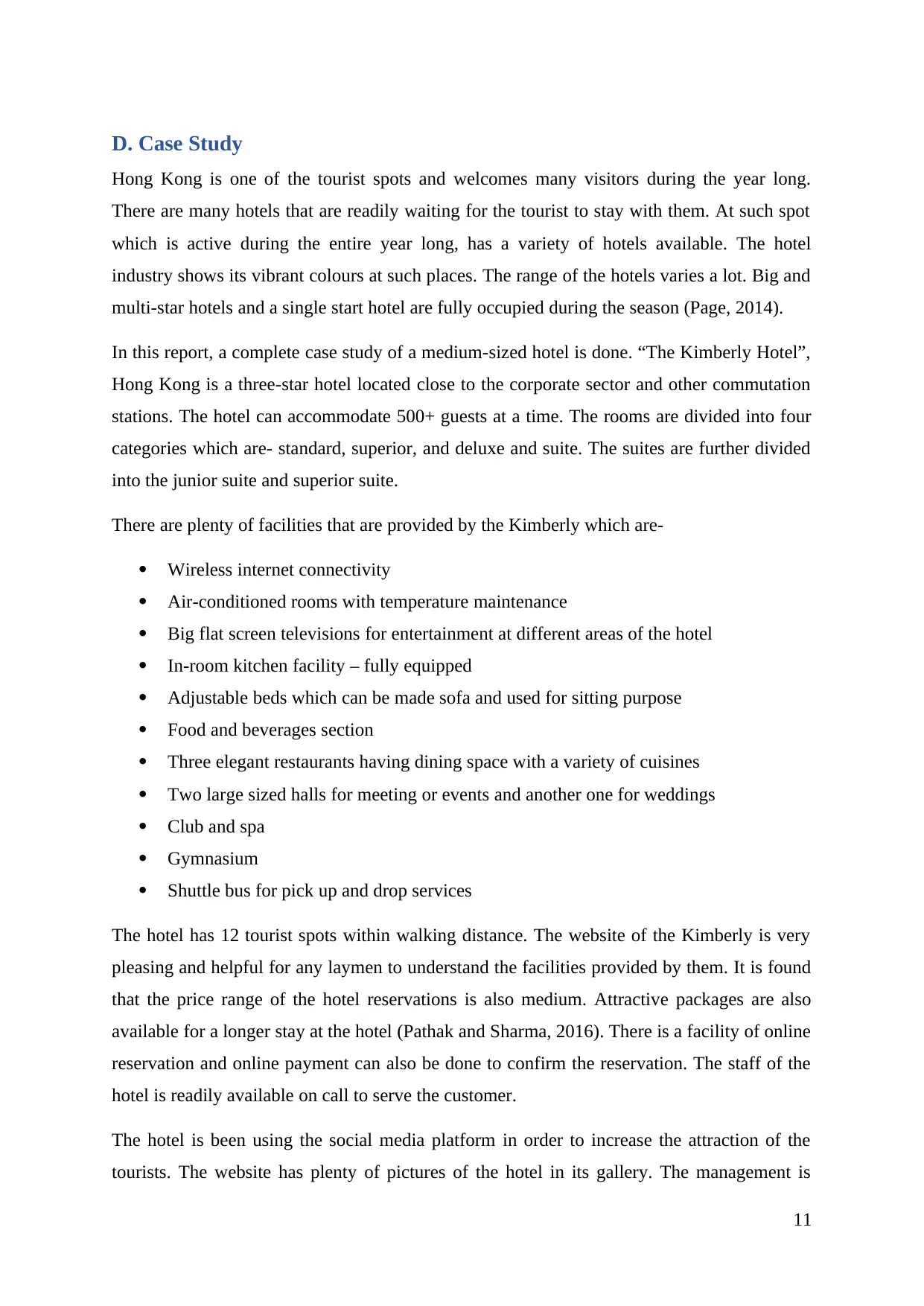
D. Case Study
Hong Kong is one of the tourist spots and welcomes many visitors during the year long.
There are many hotels that are readily waiting for the tourist to stay with them. At such spot
which is active during the entire year long, has a variety of hotels available. The hotel
industry shows its vibrant colours at such places. The range of the hotels varies a lot. Big and
multi-star hotels and a single start hotel are fully occupied during the season (Page, 2014).
In this report, a complete case study of a medium-sized hotel is done. “The Kimberly Hotel”,
Hong Kong is a three-star hotel located close to the corporate sector and other commutation
stations. The hotel can accommodate 500+ guests at a time. The rooms are divided into four
categories which are- standard, superior, and deluxe and suite. The suites are further divided
into the junior suite and superior suite.
There are plenty of facilities that are provided by the Kimberly which are-
Wireless internet connectivity
Air-conditioned rooms with temperature maintenance
Big flat screen televisions for entertainment at different areas of the hotel
In-room kitchen facility – fully equipped
Adjustable beds which can be made sofa and used for sitting purpose
Food and beverages section
Three elegant restaurants having dining space with a variety of cuisines
Two large sized halls for meeting or events and another one for weddings
Club and spa
Gymnasium
Shuttle bus for pick up and drop services
The hotel has 12 tourist spots within walking distance. The website of the Kimberly is very
pleasing and helpful for any laymen to understand the facilities provided by them. It is found
that the price range of the hotel reservations is also medium. Attractive packages are also
available for a longer stay at the hotel (Pathak and Sharma, 2016). There is a facility of online
reservation and online payment can also be done to confirm the reservation. The staff of the
hotel is readily available on call to serve the customer.
The hotel is been using the social media platform in order to increase the attraction of the
tourists. The website has plenty of pictures of the hotel in its gallery. The management is
11
Hong Kong is one of the tourist spots and welcomes many visitors during the year long.
There are many hotels that are readily waiting for the tourist to stay with them. At such spot
which is active during the entire year long, has a variety of hotels available. The hotel
industry shows its vibrant colours at such places. The range of the hotels varies a lot. Big and
multi-star hotels and a single start hotel are fully occupied during the season (Page, 2014).
In this report, a complete case study of a medium-sized hotel is done. “The Kimberly Hotel”,
Hong Kong is a three-star hotel located close to the corporate sector and other commutation
stations. The hotel can accommodate 500+ guests at a time. The rooms are divided into four
categories which are- standard, superior, and deluxe and suite. The suites are further divided
into the junior suite and superior suite.
There are plenty of facilities that are provided by the Kimberly which are-
Wireless internet connectivity
Air-conditioned rooms with temperature maintenance
Big flat screen televisions for entertainment at different areas of the hotel
In-room kitchen facility – fully equipped
Adjustable beds which can be made sofa and used for sitting purpose
Food and beverages section
Three elegant restaurants having dining space with a variety of cuisines
Two large sized halls for meeting or events and another one for weddings
Club and spa
Gymnasium
Shuttle bus for pick up and drop services
The hotel has 12 tourist spots within walking distance. The website of the Kimberly is very
pleasing and helpful for any laymen to understand the facilities provided by them. It is found
that the price range of the hotel reservations is also medium. Attractive packages are also
available for a longer stay at the hotel (Pathak and Sharma, 2016). There is a facility of online
reservation and online payment can also be done to confirm the reservation. The staff of the
hotel is readily available on call to serve the customer.
The hotel is been using the social media platform in order to increase the attraction of the
tourists. The website has plenty of pictures of the hotel in its gallery. The management is
11
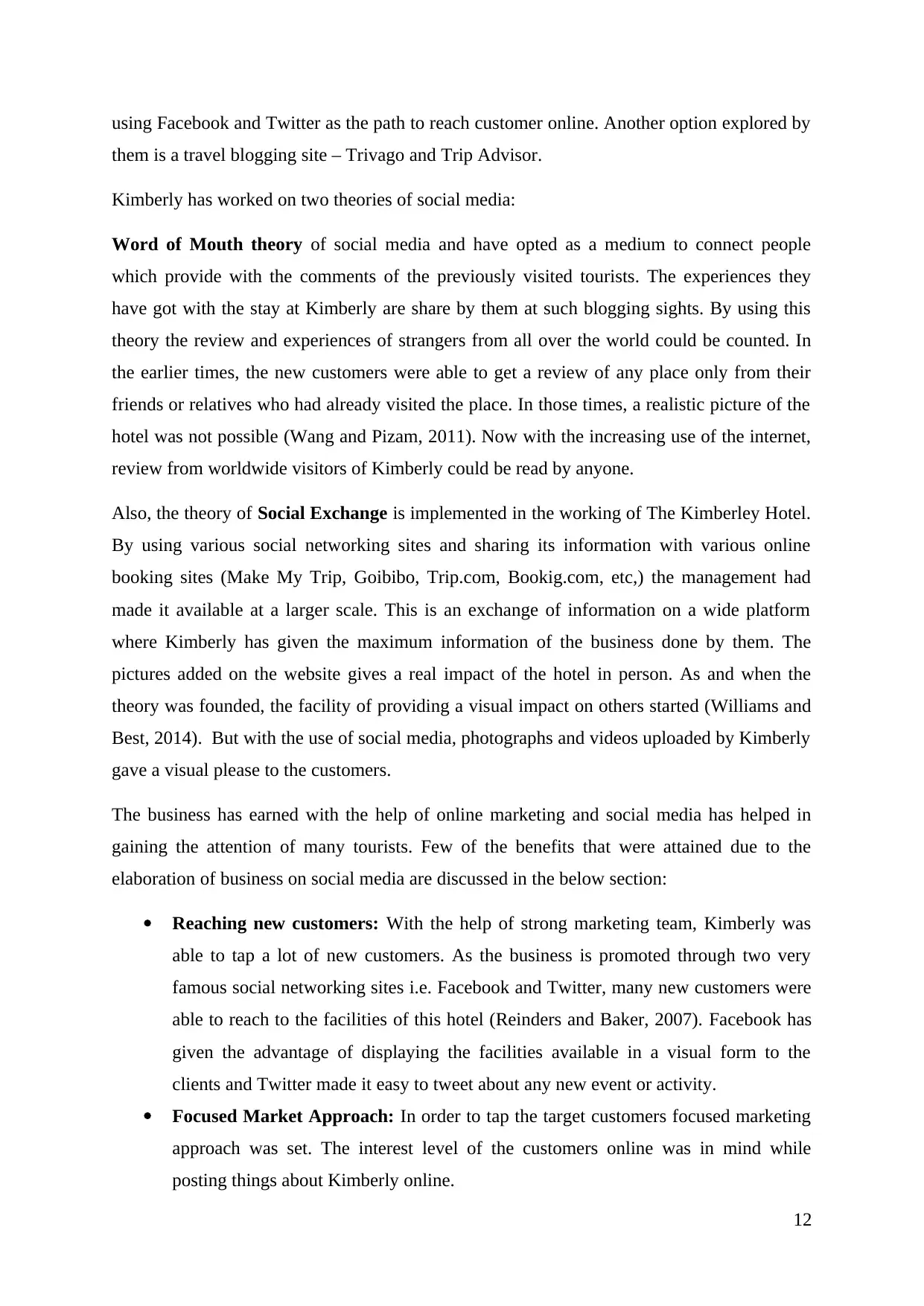
using Facebook and Twitter as the path to reach customer online. Another option explored by
them is a travel blogging site – Trivago and Trip Advisor.
Kimberly has worked on two theories of social media:
Word of Mouth theory of social media and have opted as a medium to connect people
which provide with the comments of the previously visited tourists. The experiences they
have got with the stay at Kimberly are share by them at such blogging sights. By using this
theory the review and experiences of strangers from all over the world could be counted. In
the earlier times, the new customers were able to get a review of any place only from their
friends or relatives who had already visited the place. In those times, a realistic picture of the
hotel was not possible (Wang and Pizam, 2011). Now with the increasing use of the internet,
review from worldwide visitors of Kimberly could be read by anyone.
Also, the theory of Social Exchange is implemented in the working of The Kimberley Hotel.
By using various social networking sites and sharing its information with various online
booking sites (Make My Trip, Goibibo, Trip.com, Bookig.com, etc,) the management had
made it available at a larger scale. This is an exchange of information on a wide platform
where Kimberly has given the maximum information of the business done by them. The
pictures added on the website gives a real impact of the hotel in person. As and when the
theory was founded, the facility of providing a visual impact on others started (Williams and
Best, 2014). But with the use of social media, photographs and videos uploaded by Kimberly
gave a visual please to the customers.
The business has earned with the help of online marketing and social media has helped in
gaining the attention of many tourists. Few of the benefits that were attained due to the
elaboration of business on social media are discussed in the below section:
Reaching new customers: With the help of strong marketing team, Kimberly was
able to tap a lot of new customers. As the business is promoted through two very
famous social networking sites i.e. Facebook and Twitter, many new customers were
able to reach to the facilities of this hotel (Reinders and Baker, 2007). Facebook has
given the advantage of displaying the facilities available in a visual form to the
clients and Twitter made it easy to tweet about any new event or activity.
Focused Market Approach: In order to tap the target customers focused marketing
approach was set. The interest level of the customers online was in mind while
posting things about Kimberly online.
12
them is a travel blogging site – Trivago and Trip Advisor.
Kimberly has worked on two theories of social media:
Word of Mouth theory of social media and have opted as a medium to connect people
which provide with the comments of the previously visited tourists. The experiences they
have got with the stay at Kimberly are share by them at such blogging sights. By using this
theory the review and experiences of strangers from all over the world could be counted. In
the earlier times, the new customers were able to get a review of any place only from their
friends or relatives who had already visited the place. In those times, a realistic picture of the
hotel was not possible (Wang and Pizam, 2011). Now with the increasing use of the internet,
review from worldwide visitors of Kimberly could be read by anyone.
Also, the theory of Social Exchange is implemented in the working of The Kimberley Hotel.
By using various social networking sites and sharing its information with various online
booking sites (Make My Trip, Goibibo, Trip.com, Bookig.com, etc,) the management had
made it available at a larger scale. This is an exchange of information on a wide platform
where Kimberly has given the maximum information of the business done by them. The
pictures added on the website gives a real impact of the hotel in person. As and when the
theory was founded, the facility of providing a visual impact on others started (Williams and
Best, 2014). But with the use of social media, photographs and videos uploaded by Kimberly
gave a visual please to the customers.
The business has earned with the help of online marketing and social media has helped in
gaining the attention of many tourists. Few of the benefits that were attained due to the
elaboration of business on social media are discussed in the below section:
Reaching new customers: With the help of strong marketing team, Kimberly was
able to tap a lot of new customers. As the business is promoted through two very
famous social networking sites i.e. Facebook and Twitter, many new customers were
able to reach to the facilities of this hotel (Reinders and Baker, 2007). Facebook has
given the advantage of displaying the facilities available in a visual form to the
clients and Twitter made it easy to tweet about any new event or activity.
Focused Market Approach: In order to tap the target customers focused marketing
approach was set. The interest level of the customers online was in mind while
posting things about Kimberly online.
12
⊘ This is a preview!⊘
Do you want full access?
Subscribe today to unlock all pages.

Trusted by 1+ million students worldwide
1 out of 20
Related Documents
Your All-in-One AI-Powered Toolkit for Academic Success.
+13062052269
info@desklib.com
Available 24*7 on WhatsApp / Email
![[object Object]](/_next/static/media/star-bottom.7253800d.svg)
Unlock your academic potential
Copyright © 2020–2025 A2Z Services. All Rights Reserved. Developed and managed by ZUCOL.





